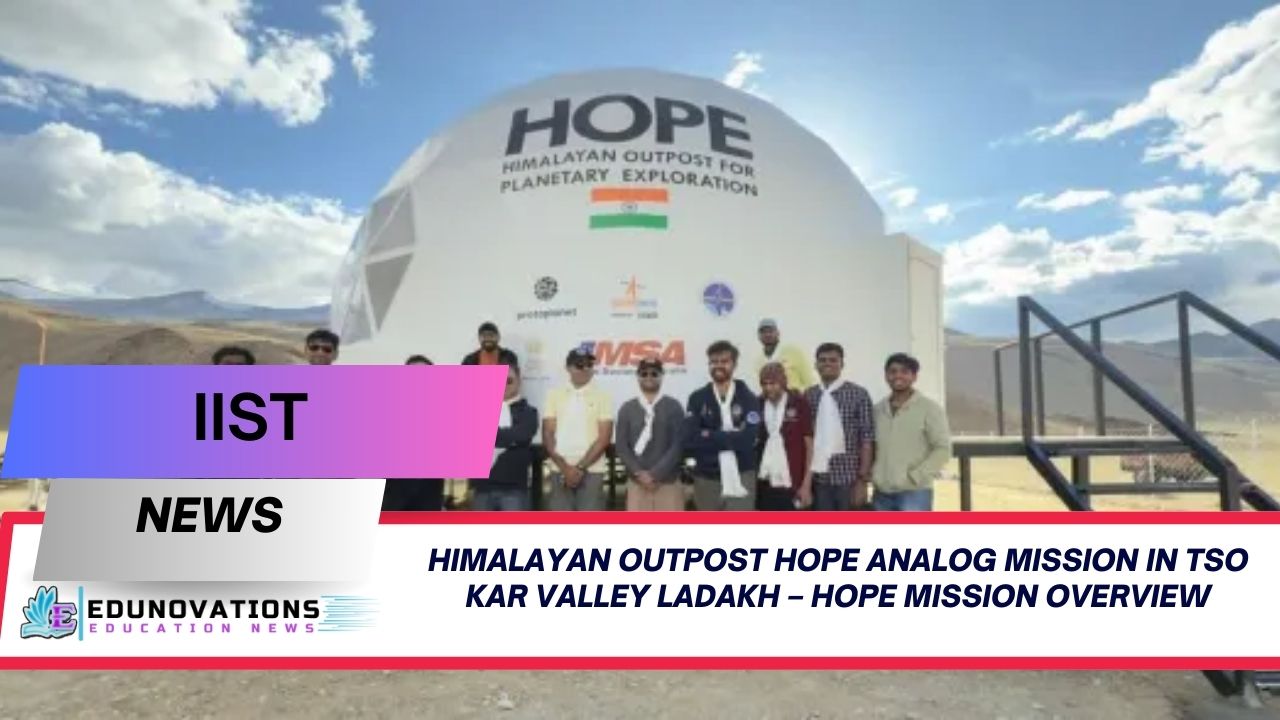Explore the Himalayan Outpost HOPE analog mission in Tso Kar Valley Ladakh, a bold rehearsal for Moon and Mars exploration, simulating analog conditions for astronaut readiness and groundbreaking research.
The Himalayan Outpost HOPE analog mission in Tso Kar Valley Ladakh: Rehearsal for the Future
In a historic stride toward human spaceflight readiness, the Himalayan Outpost HOPE analog mission in Tso Kar Valley Ladakh has taken center stage. Launched from August 1 to 10, 2025, this initiative is a meticulously designed Earth-based analog of extraterrestrial environments, led by ISRO’s Human Space Flight Centre and industry partner Protoplanet. The Himalayan Outpost HOPE analog mission in Tso Kar Valley Ladakh is more than an exercise—it’s a powerful rehearsal for future Moon and Mars missions.
Why Tso Kar Valley Was Chosen
Tso Kar Valley, perched at 4,530 meters above sea level, offers a Mars-like environment with:
- High UV radiation
- Low atmospheric pressure
- Extreme cold
- Saline permafrost
These conditions make it an exceptional natural analog to rigorously test human survival, habitat design, and life-support systems—all under realistic stress.
Toppers Use Mind Maps to score more than 95%
NCERT Class 11th Commerce Mind Maps
Add to cartOriginal price was: ₹999.00.₹199.00Current price is: ₹199.00.NCERT Class 12th Chemistry Mind Maps
Add to cartOriginal price was: ₹199.00.₹75.00Current price is: ₹75.00.NCERT Class 12th Commerce Mind Maps
Add to cartOriginal price was: ₹999.00.₹199.00Current price is: ₹199.00.NCERT Class 12th Science Mind Maps
Add to cartOriginal price was: ₹999.00.₹199.00Current price is: ₹199.00.NCERT Mind Maps For Class 10th
Add to cartOriginal price was: ₹999.00.₹199.00Current price is: ₹199.00.
Purchase Today
Mission Design & Facilities
Architecture of the HOPE Station
The Himalayan Outpost HOPE analog mission in Tso Kar Valley Ladakh features two interconnected modules:
- A dia 8-metre Habitat Module, providing living quarters for the analog crew.
- A dia 5-metre Utility Module, housing support systems and experiments.
Together, they embody a self-sustaining, compact space habitat, with integrated systems for hydroponics, circadian lighting, sanitation, and workflow efficiency—faithful to conditions astronauts will face in Lunar or Martian bases.
Key Research Focus Areas & Collaborations
Participating Institutions
The mission is a collaborative spearheaded by HSFC alongside top-tier institutions:
- IIST (Indian Institute of Space Science and Technology), Trivandrum
- RGCB (Rajiv Gandhi Centre for Biotechnology), Trivandrum
- IIT Bombay
- IIT Hyderabad
- Institute of Aerospace Medicine, Bengaluru
Research Highlights
- Health Monitoring: Experts are testing epigenetic and genomic markers via crews’ exhale breath DNA/RNA isolation, validated against blood samples in collaboration with RGCB and KIMS Health, Trivandrum, to track cardiovascular, respiratory, and neurological parameters.
- Physiological & Psychological Trials: Two crew members reside in isolation, coping with low oxygen, cognitive stressors, and circadian disruptions. Real-time monitoring reveals insights into human performance under extreme confinement.
- Operational & Microbial Protocols: Testing technologies such as hydroponics, sample collection, rover-simulations, emergency drills, and habitat workflows informing future planetary surface operations.
Long-Term Space Exploration Implications
The analog mission plays a pivotal role in India’s human spaceflight roadmap:
- Supports Gaganyaan & Beyond: Data will inform crew health systems, operations, and emergency protocols for LEO, future lunar landings, and Martian expeditions.
- Public-Private Collaboration: Protoplanet’s involvement reflects the PM’s vision of boosting private sector participation in space exploration.
- Global Relevance: HOPE joins international analog missions like NASA’s NEEMO or Mars Desert Research Station, placing India in elite company.
Internal & External Links to Boost Learning & Authority
- Looking to align this with NCERT preparation? Explore NCERT Courses, Current Affairs, Notes, MCQs, Videos, Syllabus, Downloads of Free NCERT PDFs, and Mind Maps at our internal links:
- NCERT Courses
- Current Affairs
- Notes
- MCQs
- Videos
- Syllabus
- NCERT PDF Downloads
- NCERT Mind Maps
- For authoritative external context, the Need Website for Schools Contact provides institutional credibility via Mart Ind Infotech.
Expert Perspective
As stated by Dr. V. Narayanan, Chairman of ISRO, the mission isn’t just a simulation—it is “a rehearsal for the future”, bridging the gap between terrestrial science and crewed space missions. His words highlight the mission’s practical value to Indian human spaceflight goals.
Structured Summary: Why It Matters
| Aspect | Significance |
|---|---|
| Location | Provides Mars-like conditions naturally |
| Habitat Design | Compact, self-sustaining, realistic workflow simulation |
| Research Areas | From breath genomics to psychological resilience and tech deployment |
| Collaborative Model | Combines academic, research, and private sector strengths |
| Strategic Impact | Feeds into Gaganyaan, lunar and Mars mission planning |
10 FAQs Focused on Long-Tail Keywords
- What is the Himalayan Outpost HOPE analog mission in Tso Kar Valley Ladakh used for?
It’s a simulated space habitat to test astronaut health, habitat design, and operational protocols under Moon/Mars-like Earth conditions. - How does the Himalayan Outpost HOPE analog mission in Tso Kar Valley Ladakh simulate space conditions?
By leveraging high altitude, low pressure, high UV radiation, and salty permafrost in two interconnected habitat modules. - Which institutions are involved in Himalayan Outpost HOPE analog mission in Tso Kar Valley Ladakh?
Key collaborators include IIST, RGCB, IIT Bombay, IIT Hyderabad, Institute of Aerospace Medicine, and Protoplanet. - What health research is conducted during Himalayan Outpost HOPE analog mission in Tso Kar Valley Ladakh?
Studies include exhale DNA/RNA isolation, epigenetic/genomic tracking, respiratory and neurological monitoring. - How does the Himalayan Outpost HOPE analog mission in Tso Kar Valley Ladakh benefit Gaganyaan?
It refines health protocols and systems derived from real-world simulation for crewed spacefights starting in LEO. - What are the main modules in the Himalayan Outpost HOPE analog mission in Tso Kar Valley Ladakh?
An 8-metre living habitat and a 5-metre utility support module, seamlessly connected. - Why is the Himalayan Outpost HOPE analog mission in Tso Kar Valley Ladakh considered a rehearsal for future?
It mirrors exotic extraterrestrial stressors, enabling test of crew health and protocols prior to actual space missions. - How long was the analog experiment at Himalayan Outpost HOPE analog mission in Tso Kar Valley Ladakh?
A concentrated 10-day mission from August 1 to 10, 2025. - Which research areas are advanced by Himalayan Outpost HOPE analog mission in Tso Kar Valley Ladakh?
Areas include genomics, psychological resilience, tech validation (e.g., communications, hydroponics), emergency drills. - How does Himalayan Outpost HOPE analog mission in Tso Kar Valley Ladakh align with India’s lunar goals?
It builds operational and physiological groundwork for crewed lunar landings envisioned by 2040.














